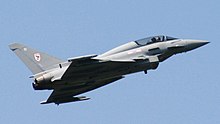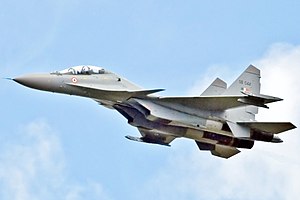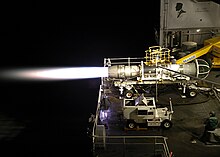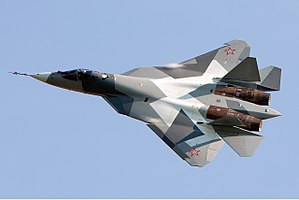Airframe

Su-30MKI's
canards and thrust-vectoring nozzles are two of the most prominent developments over the basic MK variant.
The Su-30MKI is a highly integrated
twin-finned aircraft. The airframe is constructed of
titanium and high-strength aluminium alloys. The engine
nacelles are fitted with
trouser fairings to provide a continuous streamlined profile between the nacelles and the tail beams. The
fins and horizontal tail consoles are attached to tail beams. The central beam section between the engine nacelles consists of the equipment compartment, fuel tank and the
brake parachute container. The
fuselage head is of semi-
monocoque construction and includes the
cockpit,
radar compartments and the
avionics bay.
Cockpit and ergonomics
Flight control
The aircraft has a
fly by wire (FBW) with quadruple redundancy. Depending on the flight conditions, signals from the
control stick position transmitter or the FCS will be coupled to the remote control amplifiers. These signals are combined with feedback signals fed by acceleration sensors and rate
gyros. The resultant control signals are coupled to the high-speed electro-hydraulic actuators of the
elevators,
rudders and the canard. The output signals are compared and, if the difference is significant, the faulty channel is disconnected. FBW is based on a
stall warning and barrier mechanism which prevents development of aircraft stalls through a dramatic increase in the control stick pressure. This allows a
pilot to effectively control the aircraft without running the risk of reaching the limit values of
angle of attack and acceleration. Although the maximum angle of attack is limited by the canards the FBW acts as an additional safety mechanism.
Phase 3 of further development of the MKI, will integrate avionic systems being developed for the Indo-Russian
Fifth Generation Fighter Aircraft program.
General features

Nosewheel of the Su-30MKI showing that the drag brace on the Flankers is mounted externally and fixed to the fuselage instead of the gear leg.
The displays include a highly customized version of the Israeli
Elbit Su 967
head-up display consisting of bi-cubic
phase conjugated holographic displays and seven liquid crystal multifunction displays, six 127 mm x 127 mm and one 152 mm x 152 mm. The HUD was widely misreported to be the VEH 3000 from
Thales. Variants of the same HUD have also been chosen for the IAF's
Mikoyan MiG-27 and
SEPECAT Jaguar upgrades, on grounds of standardization. Flight information is displayed on four LCD displays which include one for piloting and navigation, a tactical situation indicator, and two for display systems information including operating modes and overall operation status. The rear cockpit is fitted with a larger monochromatic screen display for the air-to-surface missile guidance. The Su-30MKI on-board health and usage monitoring system (HUMS) monitors almost every aircraft system and sub-system including the avionics sub-systems. It can also act as an engineering data recorder
Beginning in 2010, HUDs and Multi-Function Displays (MFD) will be provided by the Delhi-based
Samtel Display Systems. These are indigenously designed and built and are not part of a joint foreign venture.
Navigation
The aircraft is fitted with a satellite navigation system (A-737
GPS compatible), which permits it to make flights in all weather, day and night. The navigation complex includes the high accuracy
SAGEM Sigma-95 integrated
global positioning system and
ring laser gyroscope inertial navigation system.
Pilot ejection
The crew are provided with zero-zero KD-36DM ejection seats. The rear seat is raised for better visibility. The cockpit is provided with containers to store food and water reserves, a waste disposal system and extra
oxygen bottles. The KD-36DM ejection seat is inclined at 30°, to help the pilot resist aircraft accelerations in air combat.
Aerodynamics

Su-30 MKI opens its Parachute and Air brakes while landing at Yelahanka Air Force Base, Bangaluru during Aero India 2011
Su-30MKI aerodynamic configuration is an unstable longitudinal triplane. The canard increases the aircraft lifting ability and deflects automatically to allow high angle-of-attack (AoA) flights allowing it to perform
Pugachev's Cobra. The integral aerodynamic configuration combined with thrust vectoring results in extremely capable maneuverability, taking off and landing characteristics. This high agility allows rapid deployment of weapons in any direction as desired by the crew. The canard notably assists in controlling the aircraft at large angles-of-attack and bringing it to a level flight condition.
Radar
The forward-facing
NIIP N011M Bars (Panther) is a powerful integrated
passive electronically scanned array radar. The N011M is a digital multi-mode dual frequency band radar. The N011M can function in air-to-air and air-to-land/sea mode simultaneously while being tied into a high-precision laser-inertial or GPS navigation system. It is equipped with a modern digital weapons control system as well as anti-jamming features. N011M has a 400 km search range and a maximum 200 km tracking range, and 60 km in the rear hemisphere. The radar can track 15 air targets and engage 4 simultaneously. These targets can even include
cruise missiles and motionless helicopters. The Su-30MKI can function as a
mini-AWACS as a director or command post for other aircraft. The target co-ordinates can be transferred automatically to at least four other aircraft. The radar can detect ground targets such as
tanks at 40–50 km. The Bars radar will be replaced by
Zhuk-AESA in all Su-30MKI aircraft.




















